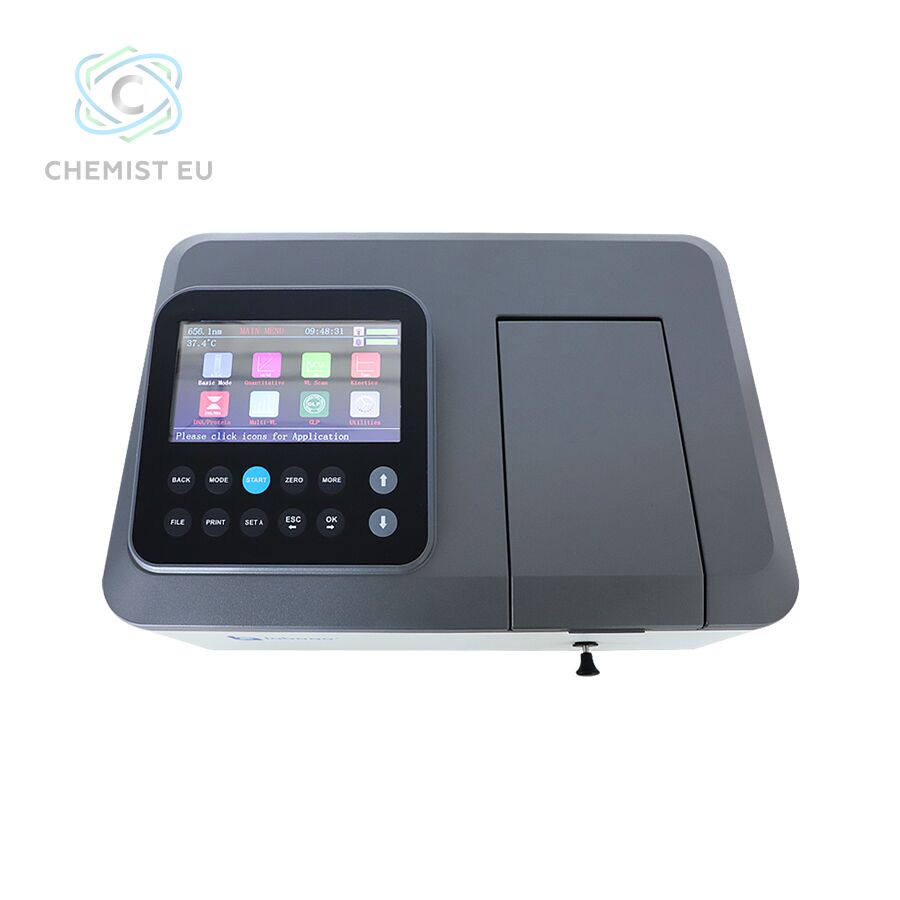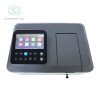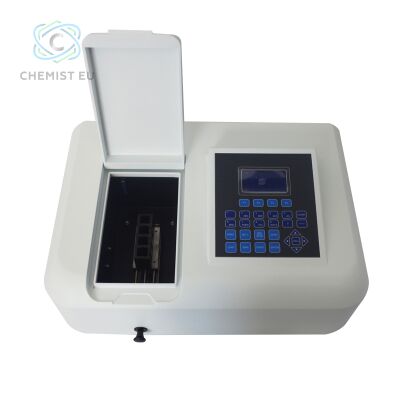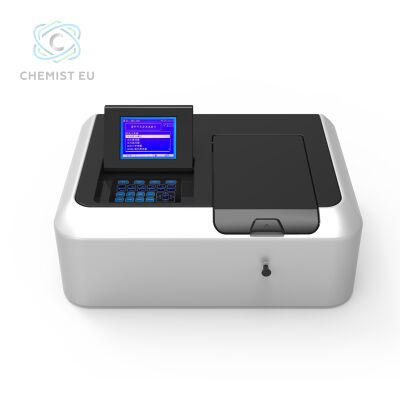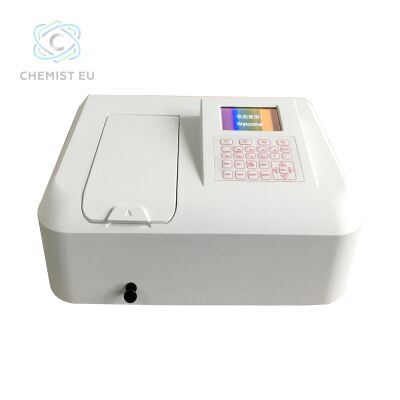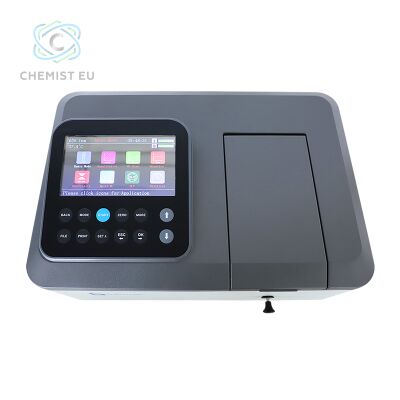DESCRIPTION
1. Photometric measurement: in the range of 190-1100nm, you can select the single-point test wavelength and test method you need to measure the absorbance or transmittance of the sample. The concentration of the sample can also be read directly by entering the standard concentration or concentration factor.
2. Quantitative measurement: Measure the sample solution of unknown concentration through the curve of known parameter factors or automatically establish the standard solution curve. It has first-order\first-order zero-crossing, second-order, third-order curve fitting, and optional single-wavelength calibration, dual-wavelength calibration, and three-point method. Standard curves can be stored and recalled.
3. Qualitative Measurements: Set a range of wavelengths, scan intervals, and perform interval absorbance, transmittance, reflectance, and energy measurements on solid or liquid samples. You can also superimpose, zoom, smooth, filter, detect peaks and valleys, save, print, etc.
4. Time measurement: Time measurement, also known as kinetic measurement, scans the sample at intervals of a time range of absorbance or transmittance at a set wavelength point. It can also be calculated by converting absorbance into concentration or reaction rate by entering a concentration factor. Enzyme kinetic reaction rate calculation. You can also choose from a variety of spectrum processing methods such as stacking, scaling, smoothing, filtering, peak-valley detection, and derivation of the measured spectrum.
5. DNA/protein measurement: The absorbance is mainly measured at 260nm/280nm/230nm/320nm, and the concentration and ratio of DNA and protein are obtained according to the calculation formula.
6. Multi-wavelength measurement: Multiple wavelength points can be set, and N wavelengths can be set to measure the absorbance or transmittance of the sample solution, and the absorbance and transmittance values at a single wavelength can be tested.
7. Instrument calibration measurement: built-in special wavelength maximum allowable error calibration, transmittance maximum allowable error measurement, stray light measurement.
8. Auxiliary functions: accumulated time of deuterium lamp, tungsten lamp lighting, deuterium lamp, tungsten lamp independent turn off and on, UV and visible light switching wavelength point selection, operation language selection (Chinese, English), automatic wavelength calibration, Bluetooth function, etc.
9. Optional PC reverse control software package functions: quantitative measurement, qualitative measurement, time measurement, DNA protein measurement, multi-wavelength measurement, 3D graphic analysis, spectrum overlay analysis, etc.
FEATURES
1. High-resolution C-T structure monochromator, good stability, reproducibility and accuracy.
2. Advanced ARM microcomputer technology, excellent electronic circuit and signal processing, stable and reliable data, U disk data storage and export, one-key software upgrade, Bluetooth printing and other data output.
3. Integrated aviation-grade aluminum alloy substrate and machined mirror base to ensure long-term stability of the optical path.
4. 7-inch touch screen color large-screen graphic liquid crystal display, with the design of navigation menu interface, clear operation commands, with special functions to prevent users from operating errors, users can operate without reading the manual touch screen + Double button operation mode, can also be operated with gloves.
5. Strict manufacturing process and 32 key quality control points make each instrument very durable.
6. Large-capacity memory, can store massive test data.
7. Key components such as deuterium lamp, tungsten lamp, photocell, and precision screw rod are all selected from well-known and imported brands to ensure the reliable quality of the instrument.
8. Four-slot 10-50mm universal adjustable manual sample holder, convenient for testing cuvettes of different specifications.
9. Independently designed replacement window for deuterium lamp and tungsten lamp, flange type positioning structure, easy to replace.
SPECIFICATIONS
| Model | LU-5 |
| Optical system | Single beam; 1200/mm imported holographic grating |
| Wavelength range | 190-1100 nm |
| Spectral Bandwidth | 2 nm |
| Maximum allowable error of wavelength | ±0.5 nm |
| Wavelength repeatability | ≤0.1 nm |
| Maximum allowable error of transmittance (%T) | ±0.3%T; ±0.002Abs (0-0.5Abs); ±0.004Abs (0.5-1.0Abs) |
| Transmittance repeatability (%T) | ±0.1%T; ±0.001Abs (0-0.5Abs); ±0.002Abs (0.5-1.0Abs) |
| %0 line and 100% line noise (%T) | 0% line 0.2/100% line 0.3 |
| Drift | ≤0.2 %T |
| Baseline flatness | ≤0.001 Abs |
| Stray light (%T) | ≤0.03 @220nm and 360nm |
| Supply voltage adaptability | ≤0.2%T |
| Photometric range | 0-200%T, -0.301-3A, 0-9999C(0-9999F) |
| Test Modes | Transmission, Reflection, Absorbance, Concentration, Energy |
| Light source | deuterium lamp + tungsten lamp |
| Display | 7 inch touch screen display (resolution 800*480) |
| System language | Chinese, English, Russian, Spanish |
| Software upgrade | support U disk one-key upgrade |
| Data output | U disk, Bluetooth, USB software upload |
| Data output format | CSV |
| Operation Mode | Touch Screen |
| Sample Holder | Four-slot 10-50mm Universal Adjustable Manual Sample Holder |
| Host function | basic+quantitative+qualitative+time+DNA+multi-wavelength |
| Printer | Optional, support Bluetooth printing |
| Power supply range | AC90~250V/ 50~60Hz |
| Dimensions (L×W×H)mm | 470×330×210 |
| Weight | 12kg |


